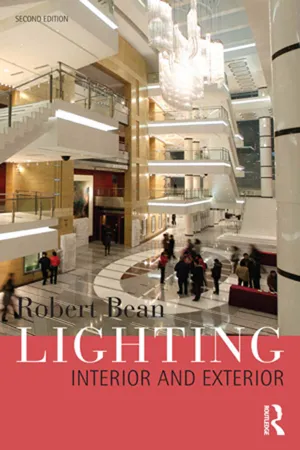
- 328 pages
- English
- ePUB (mobile friendly)
- Available on iOS & Android
Lighting: Interior and Exterior
About this book
This comprehensive and practical guide takes you step-by-step through the core concepts and applications of architectural lighting. Now completely revised and updated for the second edition, this book:
-
- Includes all new information on the latest regulations and recommendations
- Provides special attention to the rapid development of LED lighting
- Considers the new CIE colour metric system
- Concludes each chapter with questions for the reader, together with inverted appropriate answers
- Features full colour throughout, for the first time, to support the text and aid the reader
Covering a wide range of building types and external environments, this book shows how the concepts used in lighting design arise from the needs of the designer and user. These concepts are given a practical context to enable you to develop and improve your design skills, building up from the basics of how much light is needed and the role of shadows, to energy management and the calculations for daylighting, The author provides accessible, user-friendly explanations of technical information and specialist techniques intended for people who need to get to the heart of the subject as quickly as possible.
An indispensible learning tool for students, and for professionals developing their skills, this handbook provides examples and exercises to help you acquire the understanding, knowledge and skill required for examinations and professional training purposes.
Frequently asked questions
- Essential is ideal for learners and professionals who enjoy exploring a wide range of subjects. Access the Essential Library with 800,000+ trusted titles and best-sellers across business, personal growth, and the humanities. Includes unlimited reading time and Standard Read Aloud voice.
- Complete: Perfect for advanced learners and researchers needing full, unrestricted access. Unlock 1.4M+ books across hundreds of subjects, including academic and specialized titles. The Complete Plan also includes advanced features like Premium Read Aloud and Research Assistant.
Please note we cannot support devices running on iOS 13 and Android 7 or earlier. Learn more about using the app.
Information
PART ONE
Lighting concepts and resources

| Living in the luminous field | CHAPTER 1 |
Table of contents
- Cover Page
- Half Title page
- Title Page
- Copyright Page
- Contents
- Preface to second edition
- Acknowledgements
- Introduction
- Part One Lighting concepts and resources
- Chapter 1 Living in the luminous field
- Chapter 2 The importance of daylight
- Chapter 3 How much light is needed?
- Chapter 4 How lighting levels are set
- Chapter 5 Ensuring visual comfort
- Chapter 6 The importance of illuminance variations and the role played by shadows
- Chapter 7 Colour in lighting
- Chapter 8 The lit appearance of the room and the occupants
- Chapter 9 Calculations and measurements in lighting design
- Chapter 10 ‘Lumen' methods
- Chapter 11 The significance of mounting height in an interior lighting installation
- Chapter 12 Daylight calculations
- Chapter 13 Energy management
- Chapter 14 Electric lighting
- Part Two Interior lighting
- Chapter 15 Lighting for offices
- Chapter 16 Industrial lighting
- Chapter 17 Lighting for educational buildings and sports halls
- Chapter 18 Lighting for shops and stores
- Chapter 19 Lighting for public buildings and atria
- Chapter 20 Domestic lighting
- Part Three Exterior lighting
- Chapter 21 Displaying a building after dark
- Chapter 22 Outdoor sports lighting
- Chapter 23 Motorway and high-speed road lighting
- Chapter 24 Lighting for urban, amenity and residential areas
- Appendices
- Appendix 1 Typical lamp data
- Appendix 2 Illuminance, illuminance ratios, cavity reflectance: examples and observations
- Appendix 3 Effect on lamp numbers as the maintenance factors decrease
- Glossary
- Bibliography
- Index